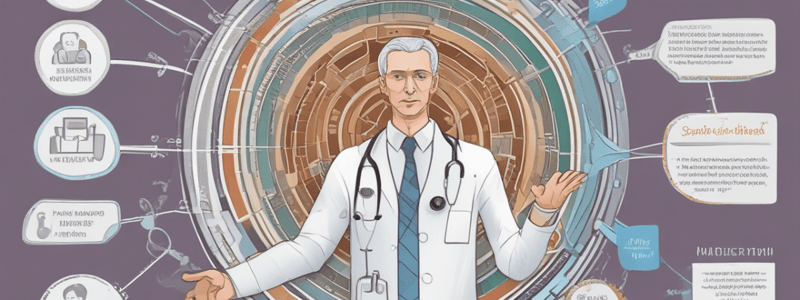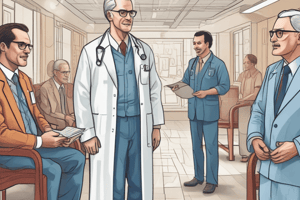Podcast
Questions and Answers
Barriers to communication can include differences in all of the following except:
Barriers to communication can include differences in all of the following except:
- Location (correct)
- Language
- Cultural background
- Sensory issues
Effective communication does not play a significant role in improving patient satisfaction.
Effective communication does not play a significant role in improving patient satisfaction.
False (B)
What are some components of nonverbal communication?
What are some components of nonverbal communication?
- Gestures
- Facial expressions
- Body posture
- All of the above (correct)
Active listening involves only hearing the words spoken by the speaker.
Active listening involves only hearing the words spoken by the speaker.
What is an example of 'defending' in a healthcare setting?
What is an example of 'defending' in a healthcare setting?
Why is discussing personal issues with a patient inappropriate?
Why is discussing personal issues with a patient inappropriate?
What is an example of 'making stereotypical comments' in a healthcare setting?
What is an example of 'making stereotypical comments' in a healthcare setting?
Why is it important to respect personal boundaries in patient encounters?
Why is it important to respect personal boundaries in patient encounters?
What is an example of 'reassuring' in a healthcare setting?
What is an example of 'reassuring' in a healthcare setting?
Why is it important for healthcare providers to be aware of their own emotions and biases?
Why is it important for healthcare providers to be aware of their own emotions and biases?
What is an example of 'probing' in a healthcare setting?
What is an example of 'probing' in a healthcare setting?
Why is active listening important in a healthcare setting?
Why is active listening important in a healthcare setting?
What is a characteristic of a functional communicator?
What is a characteristic of a functional communicator?
What is an important aspect of active listening?
What is an important aspect of active listening?
What is a key difference between verbal and nonverbal communication?
What is a key difference between verbal and nonverbal communication?
What is a benefit of using a personal communicator style?
What is a benefit of using a personal communicator style?
What is a sign of active listening?
What is a sign of active listening?
What is an important aspect of communication with patients?
What is an important aspect of communication with patients?
What is a key element of nonverbal communication?
What is a key element of nonverbal communication?
Why is active listening important in patient care?
Why is active listening important in patient care?
What is the main purpose of recognizing defense mechanisms in patients?
What is the main purpose of recognizing defense mechanisms in patients?
Which defense mechanism involves redirecting emotions towards a less threatening subject?
Which defense mechanism involves redirecting emotions towards a less threatening subject?
What is the goal of learning about defense mechanisms in patient interactions?
What is the goal of learning about defense mechanisms in patient interactions?
What is an example of the 'denial' defense mechanism?
What is an example of the 'denial' defense mechanism?
What is the common characteristic of adaptive defense mechanisms?
What is the common characteristic of adaptive defense mechanisms?
What is an example of the 'compensation' defense mechanism?
What is an example of the 'compensation' defense mechanism?
Why is it important for phlebotomists to recognize defense mechanisms?
Why is it important for phlebotomists to recognize defense mechanisms?
What is the characteristic of non-adaptive defense mechanisms?
What is the characteristic of non-adaptive defense mechanisms?
What is the primary goal of therapeutic communication in phlebotomy?
What is the primary goal of therapeutic communication in phlebotomy?
Why is it important for phlebotomists to be sensitive to patients' feelings?
Why is it important for phlebotomists to be sensitive to patients' feelings?
What is the purpose of clarifying in therapeutic communication?
What is the purpose of clarifying in therapeutic communication?
What is the benefit of using therapeutic communication techniques in phlebotomy?
What is the benefit of using therapeutic communication techniques in phlebotomy?
How can phlebotomists ensure effective communication with patients who have had difficult experiences with phlebotomy in the past?
How can phlebotomists ensure effective communication with patients who have had difficult experiences with phlebotomy in the past?
What is the purpose of exploring in therapeutic communication?
What is the purpose of exploring in therapeutic communication?
Why is it important for phlebotomists to understand some basic therapeutic communication techniques?
Why is it important for phlebotomists to understand some basic therapeutic communication techniques?
What is the primary benefit of using accepting therapeutic communication techniques?
What is the primary benefit of using accepting therapeutic communication techniques?
What can be a consequence of a patient's inability to understand medical jargon or complex instructions?
What can be a consequence of a patient's inability to understand medical jargon or complex instructions?
Why is it important for healthcare providers to be aware of their personal biases and viewpoints?
Why is it important for healthcare providers to be aware of their personal biases and viewpoints?
What can cultural differences affect in communication?
What can cultural differences affect in communication?
What is an important aspect of nonverbal communication in healthcare?
What is an important aspect of nonverbal communication in healthcare?
What is a patient's right regarding their care?
What is a patient's right regarding their care?
Why is it important for healthcare providers to be aware of language barriers?
Why is it important for healthcare providers to be aware of language barriers?
What can help healthcare providers to serve diverse populations?
What can help healthcare providers to serve diverse populations?
What is an example of a physical challenge that can affect communication in healthcare?
What is an example of a physical challenge that can affect communication in healthcare?
Using cliches and meaningless phrases in patient interactions can help build trust and rapport.
Using cliches and meaningless phrases in patient interactions can help build trust and rapport.
Patients who are experiencing stress due to acute and chronic conditions are more likely to use defense mechanisms.
Patients who are experiencing stress due to acute and chronic conditions are more likely to use defense mechanisms.
Phlebotomists should always discuss personal issues with patients to establish a rapport.
Phlebotomists should always discuss personal issues with patients to establish a rapport.
Minimizing patients' anxieties can help them feel more at ease during medical procedures.
Minimizing patients' anxieties can help them feel more at ease during medical procedures.
Respect for personal boundaries is essential in all patient encounters.
Respect for personal boundaries is essential in all patient encounters.
Probing patients about sensitive topics can help establish a better understanding of their condition.
Probing patients about sensitive topics can help establish a better understanding of their condition.
Using complex medical terminology can help patients understand a procedure better
Using complex medical terminology can help patients understand a procedure better
A patient's cultural background can affect their understanding of a procedure
A patient's cultural background can affect their understanding of a procedure
Nonverbal communication, such as maintaining eye contact, is not important in healthcare settings
Nonverbal communication, such as maintaining eye contact, is not important in healthcare settings
Language barriers can be overcome by speaking louder and more slowly
Language barriers can be overcome by speaking louder and more slowly
Patients with disabilities have the same communication needs as patients without disabilities
Patients with disabilities have the same communication needs as patients without disabilities
Recognizing and respecting patients' individual rights is a key aspect of therapeutic communication
Recognizing and respecting patients' individual rights is a key aspect of therapeutic communication
A functional communicator will typically use emotional language and connections to convey information.
A functional communicator will typically use emotional language and connections to convey information.
Active listening involves only hearing the words spoken by the speaker.
Active listening involves only hearing the words spoken by the speaker.
Nonverbal communication only includes facial expressions and body posture.
Nonverbal communication only includes facial expressions and body posture.
Verbal communication is more important than nonverbal communication in patient care.
Verbal communication is more important than nonverbal communication in patient care.
A personal communicator style is more effective when communicating with patients from different cultural backgrounds.
A personal communicator style is more effective when communicating with patients from different cultural backgrounds.
Making eye contact is not an important aspect of nonverbal communication in healthcare.
Making eye contact is not an important aspect of nonverbal communication in healthcare.
Healthcare providers do not need to be aware of language barriers when communicating with patients.
Healthcare providers do not need to be aware of language barriers when communicating with patients.
Active listening is not a vital component of communication with patients.
Active listening is not a vital component of communication with patients.
Flashcards are hidden until you start studying
Study Notes
Communication Cycle
- The communication cycle consists of sequential steps to transfer a message and receive feedback
- Process starts with the sender's idea or message and ends with a response from the receiver
- Steps: sender develops the message, chooses the route of delivery, and transmits the message
- Receiver decodes the message and provides feedback
- Effective communication occurs when both sender and receiver assign similar meanings to the message
Communication Styles
- Analytical communicators: prefer working with facts and data, little emphasis on feelings or emotions
- Intuitive communicators: prefer looking at the big picture, can result in more questions than answers
- Functional communicators: prefer organized approach with timelines and detailed plans
- Personal communicators: use emotional language and connections, care about people's thoughts and feelings
Active Listening
- Most fundamental component of communication
- Mindfully hearing and attempting to comprehend the meaning of words
- Involves making sounds or gestures that indicate attentiveness and giving feedback
- Signs of active listening: smile, eye contact, erect posture, and attention to what the speaker is conveying
Verbal vs. Nonverbal Communication
- Verbal communication: sharing information using recognizable spoken words
- Nonverbal communication: behavior that complements, negates, or substitutes for spoken words
- Includes gestures, mannerisms, facial expressions, body posture, stance, eye contact, movements, touch, personal space, and overall appearance
Therapeutic Communication
- Aims to enhance comfort, safety, trust, health, and well-being of the patient
- Focuses on patients and helps them gain a better understanding of a procedure or interaction
- Uses specific strategies that convey understanding and respect
- Encourages patients to express their feelings and ideas
Therapeutic Communication Techniques
- Accepting: acknowledge patients' statements
- Clarifying: ask for clearer explanations
- Encouraging communication: ask patients to share their feelings
- Exploring: gently persuade patients to express their thoughts
- Focusing: keep patients' attention on the information they need to understand
- Giving a broad opening: allow patients to direct the discussion
- Giving recognition: show patients recognition as individuals
- Making observations: share perceptions with patients
- Mirroring: restate patients' statements to show understanding
- Offering self: convey availability to listen and help
- Offering general leads: encourage patients to continue expressing their thoughts
- Reflecting: repeat patients' statements or questions to encourage them to value their opinions
- Remaining silent: allow patients to formulate their thoughts without pressure to converse
- Summarizing: demonstrate understanding of the conversation
Nontherapeutic Communication
- Advising: telling patients what to do outside the scope of phlebotomy practice
- Agreeing/disagreeing: implying that the phlebotomist's opinion is validating or overriding the patient's
- Defending: protecting the facility or provider while blocking further communication
- Disapproving: passing judgment on patients' thoughts or plans
- Giving approval: telling patients they are doing the right thing
- Making stereotypical comments: using clichés and meaningless phrases
- Minimizing feelings: making light of patients' anxieties
- Probing: pursuing topics patients do not want to discuss
- Reassuring: giving false hope or devaluing patients' feelings
Unhelpful Communication Patterns
- Defending: protecting the facility or provider while blocking further communication about the issue
- Disapproving: passing judgment on patients' thoughts or plans
- Giving approval: telling patients they are doing the right thing, which can lead to patients seeking approval rather than focusing on progress
- Making stereotypical comments: using clichés and meaningless phrases that show no original or patient-specific thoughts
- Minimizing feelings: making light of patients' anxieties
- Probing: pursuing topics patients do not want to discuss or that invade their privacy
- Reassuring: giving false hope or devaluing patients' feelings
Therapeutic Communication
- Accepting: hearing what patients say and following the thoughts they express
- Clarifying: asking for a clearer explanation when what patients say is vague
- Encouraging communication: asking patients to share what they are feeling
- Exploring: gently persuading patients to express their thoughts in more detail
- Focusing: keeping patients' attention on the information they need to understand
Communication Styles
- Functional communicators: preferring an organized approach with timelines and detailed plans
- Personal communicators: using emotional language and connections
Active Listening
- A fundamental component of communication
- Involves mindfully hearing and attempting to comprehend the meaning of words
- Can involve making sounds or gestures that indicate attentiveness and giving feedback in the form of a paraphrased version of what the speaker said
- Signs of active listening include a smile, eye contact, erect posture, and attention to what the speaker is conveying
Verbal vs. Nonverbal Communication
- Verbal communication: sharing information using recognizable spoken words
- Nonverbal communication: behavior that complements, negates, or substitutes for spoken words, including gestures, mannerisms, facial expressions, body posture, stance, eye contact, movements, touch, personal space, and overall appearance
Communication Challenges
- Barriers to communication include differences in language, culture, cognitive level, developmental stage, sensory issues, and physical challenges
- Poor health literacy can result in inability to understand medical jargon or complex instructions
Defense Mechanisms
- Apathy: indifference or lack of interest, feeling, concern, or emotion
- Compensation: balancing a failure or inadequacy with an accomplishment
- Denial: avoiding unpleasant or anxiety-provoking situations or ideas by rejecting them or ignoring their existence
- Displacement: redirecting emotions away from the original subject onto another less threatening subject
Defense Mechanisms in Communication
- Defending: protecting the facility or provider, blocking further communication about the issue
- Disapproving: passing judgment on patients' thoughts or plans
- Giving approval: telling patients they are doing the right thing, which can lead to seeking approval rather than progress
- Making stereotypical comments: using clichés and meaningless phrases that show no original or patient-specific thoughts
- Minimizing feelings: making light of patients' anxieties
- Probing: pursuing topics patients do not want to discuss or invading their privacy
- Reassuring: giving false hope or devaluing patients' feelings
Therapeutic Communication
- Focuses on enhancing comfort, safety, trust, health, and well-being of the patient
- Involves using specific strategies to convey understanding and respect
- Encourages patients to express their feelings and ideas
Therapeutic Communication Skills
- Accepting: hearing what patients say and following their thoughts
- Clarifying: asking for a clearer explanation when what patients say is vague
- Encouraging communication: asking patients to share their feelings
- Exploring: gently persuading patients to express their thoughts in more detail
- Focusing: keeping patients' attention on the information they need to understand
Communication Styles
- Functional communicators: prefer an organized approach with timelines and detailed plans
- Personal communicators: use emotional language and connections, caring about what people think and feel
Active Listening
- Involves mindfully hearing and attempting to comprehend the meaning of words
- Includes making sounds or gestures that indicate attentiveness and giving feedback in the form of a paraphrased version of what the speaker said
- Signs of active listening include a smile, eye contact, erect posture, and attention to what the speaker is conveying
Verbal vs. Nonverbal Communication
- Verbal communication: sharing information using recognizable spoken words
- Nonverbal communication: behavior that complements, negates, or substitutes for spoken words, including gestures, mannerisms, facial expressions, body posture, stance, eye contact, movements, touch, personal space, and overall appearance
Studying That Suits You
Use AI to generate personalized quizzes and flashcards to suit your learning preferences.



